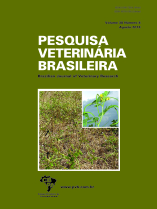 |
|
|
|
Year 2018 - Volume 38, Number 8
|

|
In vitro and in vivo efficacy of tea tree essential oil for bacterial and yeast ear infections in dogs, 38(8):1597-1607
|
ABSTRACT.- Neves R.C.S.M., Makino H., Cruz T.P.P.S., Silveira M.M., Sousa V.R.F., Dutra V., Lima M.E.K.M. & Belli C.B. 2018. In vitro and in vivo efficacy of tea tree essential oil for bacterial and yeast ear infections in dogs. [Uso in vitro e in vivo do óleo essencial de Melaleuca (Melaleuca alternifolia) em otites bacterianas e por leveduras] Pesquisa Veterinária Brasileira 38(8):1597-1607. Departamento de Clínica Médica Veterinária, Universidade Federal de Mato Grosso, Av. Fernando Corrêa da Costa 2367, Bairro Boa Esperança, Cuiabá, MT 78060-900, Brazil. E-mail: nevesrita@hotmail.com.br
Otitis externa is a common complaint in dogs. Bacteria and yeasts are commonly involved and may perpetuate inflammatory reactions inside the ear canal. Otoscopy, cytological examination of secretion and microbiological culture embody forms of diagnosis. Cytology also has great use in accessing treatment evolution. Therapy usually consists of cleaning ear canals and subsequent use of antibiotics or antifungal products. As some of them may cause hypersensitivity and even ototoxicity, searching for new pharmacological bases is currently necessary and justifies this study, which aimed to evaluate in vitro and in vivo efficacy of tea tree essential oil for bacterial and yeast ear infections in dogs. Twenty-eight dogs from a particular shelter in Cuiabá (Mato Grosso, Brazil), presenting clinical signs of otitis externa, were enrolled in this clinical trial. In all of them, clinical and cytological evaluations, as well as culture and susceptibility testing of the affected ears were carried out. From each dog, one ear was treated with 5% tea tree essential oil lotion and the other with standard otic formulation, according to the type of infection (bacterial, yeast or both). In vitro susceptibility testings of all ear cultures, to the same drugs used in treatment, were also carried out. Culture results showed 62.5% bacterial and fungal infection, 33.9% bacterial infection and 3.6% fungal infection, from the 56 ear samples collected. The most common microorganisms isolated were Staphylococcus intermedius, Staphylococcus aureus, Proteus mirabilis and Malassezia pachydermatis. Gram‑positive bacteria were susceptible to gentamycin in 60.5% and resistant in 16.3% of the samples. Five percent tea tree essential oil formulation produced a 5mm clear zone of inhibition around the disks in one of the 63 samples evaluated. Pure (100%) tea tree essential oil formulation produced a 10mm clear zone of inhibition around the disks in four of the 63 samples evaluated, a 9mm zone in three samples, an 8mm zone in 16 samples, a 7mm zone in seven samples, a 6mm zone in two samples and there was no clear zone in 31 samples. Inhibition zones were produced by strains of Staphylococcus intermedius, Staphylococcus hyicus, Corynebacterium sp., Proteus mirabilis and Enterobacter sp. tea tree essential oil ear solution significantly induced remission of clinical signs both in bacterial and yeast ear infections. It also reduced as much Malassezia pachydermatis ear infection as the nystatin solution used in this study, while gentamycin solution showed better antibacterial effect. More studies should be conducted to evaluate in vitro diffusion properties of tea tree essential oil. Good antimicrobial spectrum and the absence of adverse reactions confirm the importance of developing a tea tree formulation as an alternative therapy for ear infections in dogs. |
| |
|
|
| |
|
 |